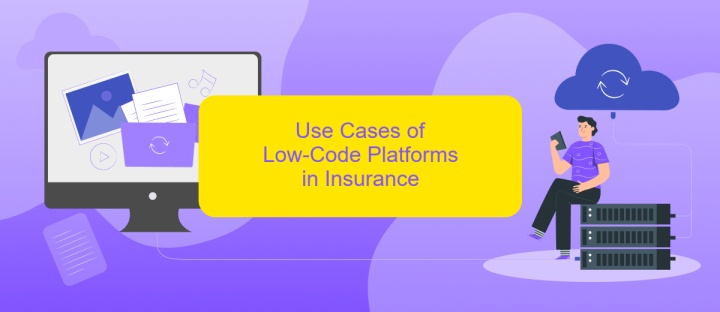Low-Code for Insurance
In the rapidly evolving insurance industry, the demand for innovative solutions is at an all-time high. Low-code platforms are emerging as a game-changer, enabling insurance companies to streamline processes, enhance customer experiences, and accelerate digital transformation. By reducing the need for extensive coding, these platforms empower insurers to quickly develop and deploy custom applications, fostering agility and competitiveness in a dynamic market landscape.
Understanding the Low-Code Landscape in Insurance
The low-code approach is revolutionizing the insurance industry by enabling faster development and deployment of applications. This paradigm reduces the need for extensive coding knowledge, allowing insurers to streamline operations and enhance customer experiences. By leveraging visual development tools, insurance companies can swiftly adapt to market changes and regulatory requirements, fostering innovation and agility.
- Accelerated application development: Low-code platforms significantly cut down the time required to build and launch applications.
- Enhanced collaboration: Business and IT teams can work more closely, aligning goals and outcomes effectively.
- Cost efficiency: Reduced development time and resource needs lead to lower operational costs.
- Scalability: Easily adjust and scale applications to meet evolving business demands.
As the insurance sector faces increasing competition and customer expectations, low-code solutions offer a strategic advantage. Insurers can quickly introduce new products, improve customer interactions, and maintain compliance with minimal resources. Embracing low-code technology not only transforms internal processes but also positions companies to stay ahead in a rapidly changing digital landscape.
Benefits of Low-Code Development for Insurers

Low-code development offers significant advantages for insurers, primarily by accelerating the deployment of applications and reducing costs. With low-code platforms, insurance companies can streamline their operations by automating routine tasks and improving their customer service capabilities. This approach allows insurers to quickly adapt to market changes and regulatory requirements, enhancing their competitive edge. Additionally, low-code platforms enable faster prototyping and testing, which helps in swiftly addressing customer feedback and improving service offerings.
Moreover, low-code solutions facilitate seamless integration with existing systems, reducing the complexity of IT infrastructure. Services like ApiX-Drive can further enhance this integration process by providing tools that connect various applications and automate data flows, ensuring that insurers can easily manage and synchronize information across platforms. This not only improves operational efficiency but also enhances data accuracy and accessibility. As a result, insurers can focus more on innovation and customer satisfaction, rather than being bogged down by technical challenges.
Use Cases of Low-Code Platforms in Insurance

Low-code platforms are revolutionizing the insurance industry by streamlining processes and enhancing customer experiences. These platforms allow insurers to develop applications rapidly with minimal coding, facilitating faster response to market demands and regulatory changes. By empowering non-technical staff to participate in app development, insurers can innovate more efficiently and reduce operational costs.
- Policy Management: Low-code platforms enable the swift creation of applications for managing policies, from issuance to renewal, improving efficiency and accuracy.
- Claims Processing: Automating claims processing with low-code solutions can significantly reduce the time required to assess and settle claims, enhancing customer satisfaction.
- Customer Engagement: Insurers can develop personalized customer portals and mobile apps, improving communication and service delivery.
- Regulatory Compliance: Low-code platforms help in quickly updating systems to comply with new regulations, ensuring that insurers remain compliant without extensive IT intervention.
- Risk Assessment: By integrating data analytics tools, low-code platforms aid in developing sophisticated risk assessment models, providing better insights and underwriting accuracy.
As the insurance industry continues to evolve, low-code platforms offer a strategic advantage by enabling rapid innovation and operational agility. Insurers adopting these technologies can stay competitive, meet customer expectations, and adapt to ever-changing market conditions.
Choosing the Right Low-Code Platform for Your Insurance Needs

When selecting a low-code platform for your insurance company, it's crucial to evaluate specific features that align with your business objectives. A suitable platform can streamline processes, enhance customer experiences, and reduce operational costs. Start by identifying your organization's unique requirements and the challenges you aim to address with a low-code solution.
Consider the platform's scalability and integration capabilities. It's essential to ensure that the platform can grow with your business and seamlessly integrate with existing systems. Additionally, assess the platform's security features, as protecting sensitive customer data is paramount in the insurance industry.
- User-friendly interface and ease of use
- Robust security and compliance features
- Seamless integration with existing systems
- Scalability to accommodate business growth
- Strong customer support and community resources
Ultimately, choosing the right low-code platform involves balancing your current needs with future growth potential. By carefully evaluating these factors, your insurance company can leverage low-code technology to drive innovation and maintain a competitive edge in the market.


Future Trends of Low-Code in the Insurance Industry
The future of low-code platforms in the insurance industry is poised for significant transformation. As insurers strive to enhance customer experience and streamline operations, low-code solutions offer a flexible and efficient approach to application development. These platforms enable insurers to rapidly deploy new features and services, adapting to evolving market demands without the lengthy timelines associated with traditional coding. With a growing emphasis on digital transformation, low-code is expected to play a pivotal role in automating processes, reducing costs, and improving agility in the insurance sector.
Integration capabilities are a critical aspect of this transformation, as insurers require seamless connectivity between various systems and services. Tools like ApiX-Drive facilitate these integrations by providing a user-friendly interface to connect different applications without extensive coding knowledge. This ability to easily integrate and automate workflows will empower insurers to enhance their service offerings and respond more swiftly to customer needs. As low-code platforms continue to evolve, they will likely incorporate advanced technologies such as AI and machine learning, further revolutionizing the way insurance companies operate and deliver value to their clients.
FAQ
What is Low-Code and how can it benefit the insurance industry?
How can Low-Code platforms help in automating insurance processes?
Are there specific Low-Code tools that integrate well with existing insurance systems?
What are the security implications of using Low-Code platforms in insurance?
How can Low-Code platforms enhance customer experience in insurance?
Apix-Drive will help optimize business processes, save you from a lot of routine tasks and unnecessary costs for automation, attracting additional specialists. Try setting up a free test connection with ApiX-Drive and see for yourself. Now you have to think about where to invest the freed time and money!

